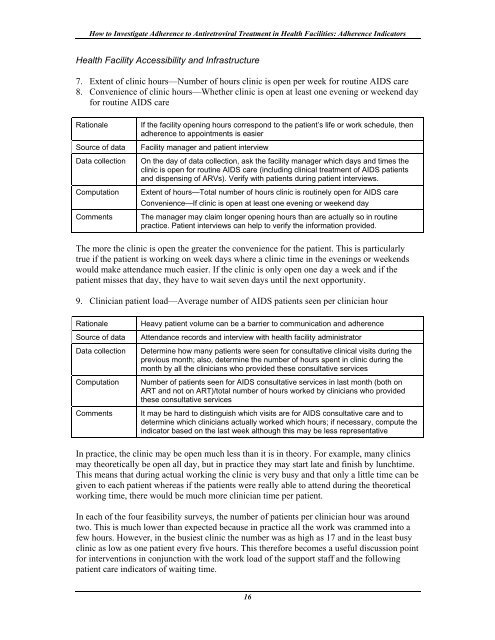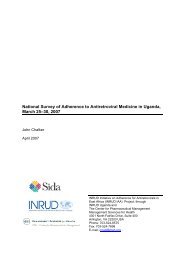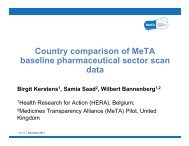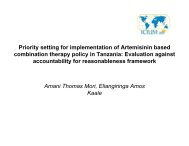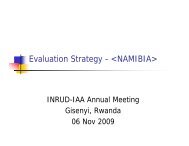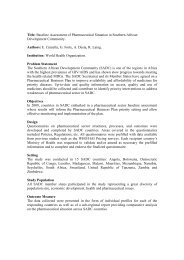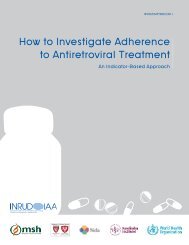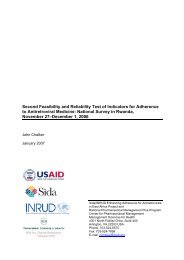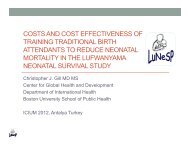How to investigate Adherence to Antiretroviral Treatment ... - INRUD
How to investigate Adherence to Antiretroviral Treatment ... - INRUD
How to investigate Adherence to Antiretroviral Treatment ... - INRUD
You also want an ePaper? Increase the reach of your titles
YUMPU automatically turns print PDFs into web optimized ePapers that Google loves.
<strong>How</strong> <strong>to</strong> Investigate <strong>Adherence</strong> <strong>to</strong> <strong>Antiretroviral</strong> <strong>Treatment</strong> in Health Facilities: <strong>Adherence</strong> Indica<strong>to</strong>rs<br />
Health Facility Accessibility and Infrastructure<br />
7. Extent of clinic hours—Number of hours clinic is open per week for routine AIDS care<br />
8. Convenience of clinic hours—Whether clinic is open at least one evening or weekend day<br />
for routine AIDS care<br />
Rationale<br />
Source of data<br />
Data collection<br />
Computation<br />
Comments<br />
If the facility opening hours correspond <strong>to</strong> the patient’s life or work schedule, then<br />
adherence <strong>to</strong> appointments is easier<br />
Facility manager and patient interview<br />
On the day of data collection, ask the facility manager which days and times the<br />
clinic is open for routine AIDS care (including clinical treatment of AIDS patients<br />
and dispensing of ARVs). Verify with patients during patient interviews.<br />
Extent of hours—Total number of hours clinic is routinely open for AIDS care<br />
Convenience—If clinic is open at least one evening or weekend day<br />
The manager may claim longer opening hours than are actually so in routine<br />
practice. Patient interviews can help <strong>to</strong> verify the information provided.<br />
The more the clinic is open the greater the convenience for the patient. This is particularly<br />
true if the patient is working on week days where a clinic time in the evenings or weekends<br />
would make attendance much easier. If the clinic is only open one day a week and if the<br />
patient misses that day, they have <strong>to</strong> wait seven days until the next opportunity.<br />
9. Clinician patient load—Average number of AIDS patients seen per clinician hour<br />
Rationale<br />
Source of data<br />
Data collection<br />
Computation<br />
Comments<br />
Heavy patient volume can be a barrier <strong>to</strong> communication and adherence<br />
Attendance records and interview with health facility administra<strong>to</strong>r<br />
Determine how many patients were seen for consultative clinical visits during the<br />
previous month; also, determine the number of hours spent in clinic during the<br />
month by all the clinicians who provided these consultative services<br />
Number of patients seen for AIDS consultative services in last month (both on<br />
ART and not on ART)/<strong>to</strong>tal number of hours worked by clinicians who provided<br />
these consultative services<br />
It may be hard <strong>to</strong> distinguish which visits are for AIDS consultative care and <strong>to</strong><br />
determine which clinicians actually worked which hours; if necessary, compute the<br />
indica<strong>to</strong>r based on the last week although this may be less representative<br />
In practice, the clinic may be open much less than it is in theory. For example, many clinics<br />
may theoretically be open all day, but in practice they may start late and finish by lunchtime.<br />
This means that during actual working the clinic is very busy and that only a little time can be<br />
given <strong>to</strong> each patient whereas if the patients were really able <strong>to</strong> attend during the theoretical<br />
working time, there would be much more clinician time per patient.<br />
In each of the four feasibility surveys, the number of patients per clinician hour was around<br />
two. This is much lower than expected because in practice all the work was crammed in<strong>to</strong> a<br />
few hours. <strong>How</strong>ever, in the busiest clinic the number was as high as 17 and in the least busy<br />
clinic as low as one patient every five hours. This therefore becomes a useful discussion point<br />
for interventions in conjunction with the work load of the support staff and the following<br />
patient care indica<strong>to</strong>rs of waiting time.<br />
16


